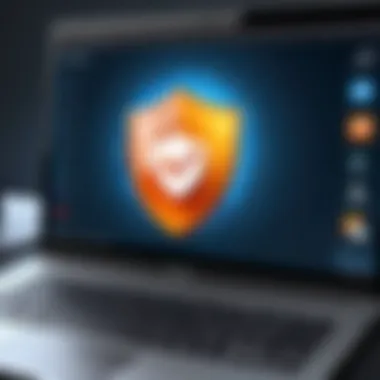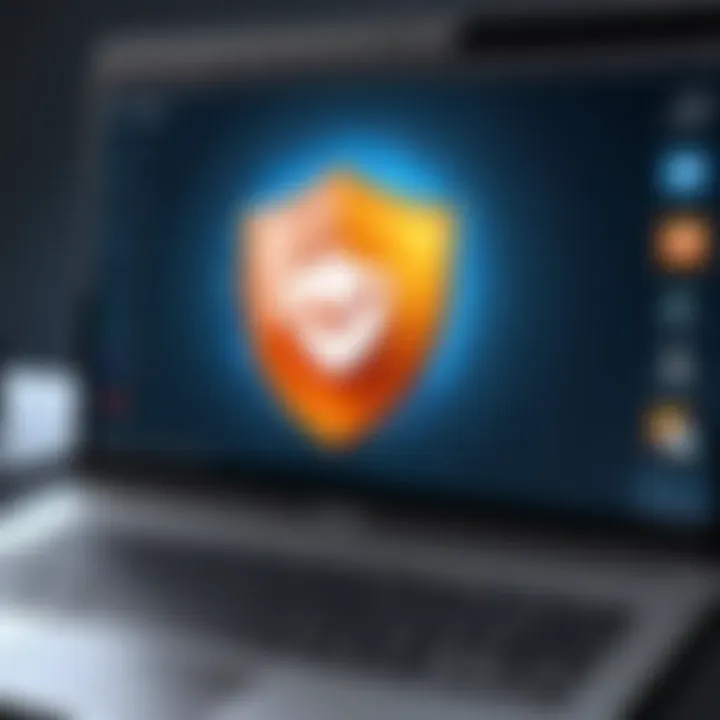How to Download Antivirus Software for Windows 7


Intro
In today's digital landscape, the importance of having robust antivirus protection cannot be overstated, especially for users running Windows 7. While it may be a legacy operating system, millions still rely on it for everyday tasks. Unfortunately, this popularity makes it a prime target for malware and cyber threats. Without proper protection, users can find themselves vulnerable to data breaches and identity theft.
This comprehensive guide aims to equip you with the knowledge needed to select and download suitable antivirus software that will bolster your system's defenses. By delving into the various options available and offering a step-by-step approach, we ensure that the process remains straightforward, even for those not well-versed in technology. Understanding the significance of antivirus protection for Windows 7 is the first step to safeguarding your device and personal information.
As we move through this guide, we will touch on the various types of antivirus software, their essential features, and common issues users face during downloads. Whether you're seeking real-time protection, spyware detection, or a user-friendly interface, we will help you navigate through these choices. Ultimately, our goal is to provide you with the tools and strategies necessary to maintain optimal security and performance for your Windows 7 system.
Foreword to Windows Antivirus
In today’s world, where digital threats lurk behind every click, it’s vital for users of Windows 7 to understand the necessity of antivirus software. Windows 7, despite being an older operating system, still sees wide usage among personal and professional users. This means the need for robust security measures is every bit as pressing as it is for newer systems. Protecting your machine isn’t just optional; it’s paramount.
Why Antivirus is Essential
Antivirus software acts as a digital shield against malware, viruses, and other threats that can compromise not only your device but all your sensitive information. The average user may not always realize how vulnerable their system can be, especially when browsing the web, downloading files, or interacting with unfamiliar emails. By having antivirus software in place, users benefit from:
- Real-time Protection: Continuous monitoring helps catch threats as they appear, unlike traditional methods that only detect issues after they have occurred.
- Malware Removal: An effective antivirus program can identify and remove malware that may have infiltrated your system, restoring your machine to its former state.
- Safe Browsing Features: Many antivirus solutions include web protection that warns users when they are about to visit possibly harmful websites.
- Data Privacy: By preventing data breaches, antivirus software helps keep personal information like passwords and credit card details safe.
Without antivirus software, users put themselves at risk for identity theft, data loss, and system damage. Therefore, taking the step to download and install such software is not just a good idea—it's essential.
Unique Challenges of Windows
While Windows 7 has been a stalwart of countless desktops and laptops, it presents unique challenges. Microsoft officially ended support for Windows 7 in January 2020. This means no more security updates directly from Microsoft, leaving the operating system open to new threats and vulnerabilities.
Given this reality, users face the daunting task of choosing antivirus solutions that still offer support for this particular system. Some of the challenges include:
- Compatibility Issues: As antivirus developers push updates and new technologies, some may not support Windows 7, leaving users at risk.
- Limited Features: Newer antivirus software might not be optimized for Windows 7, potentially lacking features that would enhance overall protection.
- Increased Vulnerability: Being unprotected and unsupported, Windows 7 devices can easily become targets for cybercriminals looking to exploit outdated systems.
In short, navigating the antivirus landscape specific to Windows 7 requires a keen understanding of the available options and considerations, ensuring that users do not compromise their security.
Exploring Antivirus Options
When it comes to preserving the integrity of your Windows 7 system, exploring antivirus options feels like gathering the tools before diving into a DIY project. It’s crucial to sift through available choices, weighing their features, benefits, and potential drawbacks. This step not only ensures your system stays free from malware, but it can save your data and enhance overall performance. The selection of antivirus software will define your protection level, indicating that thoughtful consideration here can fortify your security.
Popular Antivirus Software for Windows
Norton Antivirus
Norton Antivirus has long been a household name in the software world. Its reputation is built on providing robust protection against various types of cyber threats. One of the standout characteristics of Norton is its high detection rate of known viruses and emerging threats. Its ability to adapt and respond swiftly to new malware makes it a favored choice among users who prioritize safety.
Moreover, many appreciate its user-friendly interface. Navigating the features feels intuitive, meaning you can manage settings without feeling like you're trying to decipher hieroglyphics. A unique feature of Norton is its cloud-based protection, which allows for quicker updates as new threats come onto the scene. However, potential users should note that Norton can be resource-intensive, so it’s best to evaluate your system’s capabilities before diving into a subscription.
McAfee Total Protection
McAfee Total Protection is another heavyweight contender in the antivirus ring. What sets it apart is the solid all-in-one solution it provides, integrating features like a firewall, identity theft protection, and secure browsing. This comprehensive package offers a peace of mind that can’t be understated.
One of the key highlights of McAfee is its multi-device support, allowing you to protect several gadgets with a single subscription. This flexibility is particularly appealing for users who operate multiple devices or want to secure family systems. A unique advantage is the Virus Pledge, a promise that McAfee will help remove viruses or refund your money, should they cause issues on your system. On the flip side, it can slow down your system while running scans, so scheduling those for times you’re not using your device is advisable.
Kaspersky Antivirus
Kaspersky Antivirus garners attention for its impressive malware detection capabilities and minimal impact on system speed when it’s running. Its intuitive dashboard enables users to monitor their system easily, and the software is celebrated for its effectiveness against various online threats. One key feature is its Privacy Protection, which includes tools to help manage your online identity and secure your data from prying eyes.
Kaspersky also provides a vulnerability scanner to identify weak points in your system—something that most antivirus suites don’t highlight. This can be particularly useful for Windows 7 users concerned about security weaknesses inherent in an older operating system. However, some users are wary of privacy concerns due to Kaspersky’s Russian origin, so it’s best to weigh those factors according to your needs.
Free vs. Paid Antivirus Programs


Diving into the decision of whether to opt for free or paid antivirus programs is an old chestnut that stirs up more debate than a heated family dinner. Free antivirus offerings might seem appealing—after all, no one likes to shell out cash unnecessarily. However, these often come with limitations such as fewer features, lower detection rates, and less frequent updates.
On the otherhand, paid antivirus software typically provides comprehensive protection with continuous updates, priority customer support, and a broader feature set. This can include email scanning, real-time protection, and additional tools for safe online transactions.
It’s essential to evaluate your needs—if you’re running a system that handles sensitive information, investing in a reputable paid program may edge out the free alternatives. To summarize:
- Free Antivirus Pros:
- Free Antivirus Cons:
- Paid Antivirus Pros:
- Paid Antivirus Cons:
- No cost involved.
- Basic protection against common threats.
- Limited features.
- Less frequent updates and weaker overall protection.
- Comprehensive security features.
- Better customer support and timely updates.
- Recurring costs that can add up.
While exploring antivirus options might not be the most glamorous task, doing your homework here pays off in the end.
Steps to Download Antivirus on Windows
Downloading antivirus software for Windows 7 isn’t just a walk in the park; it requires due diligence and a methodical approach. This section lays out a clear framework for ensuring that your download is smooth, safe, and effective. The right preparation can make all the difference in your tech experience. From checking system compatibility to finding trustworthy sources, each step is building towards a robust defense against potential threats that loom over your system.
Preparation Before Downloading
Before you plunge into downloading antivirus software, it’s smart to hit the brakes and do a bit of homework. Preparation is key in this regard and involves two significant aspects, each contributing directly to a successful download experience.
Checking System Requirements
The first step is checking system requirements. This is crucial because every software has its own set of specs that your system must meet. Ignoring this can lead to compatibility issues that defeat the purpose of having antivirus software in the first place.
When we talk about system requirements, we’re usually looking at a few key numbers: the minimum amount of RAM, the necessary disk space, and the processor type. For instance, many antivirus programs now demand at least 2 GB of RAM and 1 GB of free space. Why is this such a beneficial aspect? Because having a compatible antivirus ensures that it functions smoothly, without hogging resources or causing system slowdowns.
One unique feature of checking system requirements is the ability to assess your hardware longevity. This can help you identify whether it’s time for hardware upgrades or if you're simply good to go with what you currently have. However, if you don’t align these specs, you might end up installing software that will not work effectively, making the exercise pointless.
Disabling Previous Antivirus Software
Next up is disabling previous antivirus software. It may seem counterintuitive, but having two antivirus programs active can create conflicts, potentially leading to lapses in protection. One important aspect of disabling previous software is understanding that you’re clearing the deck for a new arrival.
The key characteristic here is that it prevents software interference, ensuring that the freshly installed antivirus can operate without snags or setbacks. By doing this, not only are you maintaining a coherent performance, but you’re also protecting yourself from potential threats rather than inviting them in.
Disabling old software offers another unique edge: it allows you to uninstall features you may not even need anymore, making space for new and better protections. On the downside, remember that some uninstallation processes can be cumbersome or require an extra reboot. It’s a small price to pay for ensuring your digital safety.
Finding a Reliable Source
Now that you’ve prepped your system, it’s time to find the right source for your antivirus software. Not all download avenues are created equal.
Official Websites
First off, let’s talk about official websites. Downloading directly from the official site of the antivirus provider is the gold standard for a reason. It not only guarantees authenticity, but it also ensures that you’re getting the most updated version available.
An undeniable advantage of going down this route is the peace of mind that comes from knowing you’re getting a legitimate product. This diminishes the risk of malware hiding under the guise of antivirus. Moreover, official sites often have other useful resources, such as installation guides or customer service support.
However, one drawback is that sometimes these official sites are less user-friendly or can be cluttered with too much information. Navigating can take some time, but it’s often worth the effort to remain on the safe side.
Trusted Third-Party Sites


While official websites are the safest bet, some users prefer trusted third-party sites for their convenience and ease of use. Sites like CNET or Softpedia, for example, curate software options and often present them in a user-friendly manner.
A key characteristic here is the broader range of software that such sites can provide, allowing users to compare multiple options in one fell swoop. This can save time and effort when searching for the best antivirus fit.
Still, tread carefully. While many of these sites do vet their selections, the risk of downloading something fraudulent can linger. Always double-check reviews or corroborate information you find. The unique feature of these websites is their ability to highlight user experiences and reviews, providing a wealth of insight that might not be available on official platforms.
Initiating the Download
Once you've found the right software, it’s all about initiating the download. This is relatively straightforward but comes with its own considerations.
Selecting the Right Version
One of the first things to do is select the right version for your Windows 7 system. Most antivirus programs offer several versions targeting different needs, be it basic protection or comprehensive solutions that include features like VPNs or phishing protection.
Understanding what each version offers can help you strike that delicate balance between cost and necessity. If you need basic protection without the bells and whistles, going for a bare-bones version can save you money without any unnecessary complication. The main characteristic here is that recognizing your needs can lead to smarter choices, saving both time and funds.
The unique feature of selecting the right version also means that you are provided a tailored experience, leading to a more efficient process. On the flip side, the downside is that with so many choices available, it may cause decision fatigue. However, doing even a bit of research can quite easily overcome that hurdle.
Choosing Download Options
Finally, let's discuss choosing download options. This is where you can select preferences during the downloading phase, such as language and installation location. It might sound trivial, but these choices can impact how user-friendly the software will be when it comes time to use it.
One key characteristic is the flexibility these options give you, helping to customize the installation process. It’s especially beneficial for those who may have a specific preference in how they want their software to behave on their systems.
However, a unique downside to this is that there may be additional clutter. Sometimes, the software may try to include optional installs or toolbars that you may not want. It’s essential to stay vigilant and read through the options before hitting download.
With that, you’re all set to kick off the download process while ensuring everything goes off without a hitch. The steps outlined thus far lay a robust foundation for the next phase in your journey towards enhanced security on Windows 7.
Installation Process for Antivirus
Installing antivirus software is a pivotal step in bolstering the security of your Windows 7 system. It goes beyond just providing a shield against malicious attacks; a smooth installation ensures that your system can swiftly adapt to the incoming security policies. An efficient installation process lays the groundwork for active monitoring, updates, and scanning capabilities that keep your digital environment safe from a myriad of threats.
When selecting antivirus software, you might find yourself overwhelmed with choices. But remember, the installation experience should be seamless. A poorly executed installation can lead to various issues, such as software crashes, conflicts with other programs, or, in the worst-case scenario, leaving your system vulnerable. Thus, understanding the installation process becomes paramount not just for keeping your system secure but also for optimizing its overall performance.
Step-by-Step Installation Guide
Navigating the installation of antivirus software is not rocket science, but it does require a careful approach. Here's a step-by-step guide to help ensure a successful setup:
- Download the Software: First, make sure that you've selected the right software. After downloading, find the installation file, typically saved in your Downloads folder.
- Run the Installation File: Right-click on the installation file and select "Run as Administrator." This step gives the program the necessary permissions needed during setup.
- Follow the Installation Wizard: Next, an installation wizard will pop up. Read through the terms and conditions. It's best practice to go through them, even if it seems tedious. Accept them to proceed.
- Customize Installation Preferences: Most antivirus software allows you to choose a custom installation option. Here, you can select features you want to install. If you're unsure, it's usually best to opt for the default settings.
- Finalize Installation: Once you've made your selections, click on the "Install" button. This process can take several minutes, so be patient.
- Restart Your Computer: Often, the software will prompt you to restart your system. This reboot helps to integrate the antivirus into the system fully.
- Complete Initial Configuration: Upon reboot, you'll need to complete the initial configuration. This may involve logging in with your account details or creating a new user profile.
Following these steps carefully minimizes the risk of errors and conflicts.
Configuring Antivirus Settings
Once your antivirus software is installed, the next vital part is configuration. Effective setup settings can enhance your protection and streamline your usage experience. Here are some essential settings you should consider:
- Real-Time Protection: Ensure that this feature is activated. It provides continuous monitoring and shields your system from threats as they arise.
- Scheduled Scans: Establish a regular scanning schedule. Whether it's daily, weekly, or monthly, having automatic scans ensures you stay on top of potential issues, especially if new threats pop up.
- Update Settings: Configure the update frequency for your virus definitions. Keeping your software updated is crucial, as new virus signatures are released frequently.
- Exclusions: If you notice the antivirus is flagging certain safe files or applications, adjust your exclusions list to prevent unnecessary alerts. However, exercise caution and only add files you trust.
- Firewall Settings: Check if your antivirus includes a firewall and if so, ensure it’s properly configured. A firewall adds an additional layer of protection by monitoring incoming and outgoing traffic.
Configuring your antivirus settings will help create an environment where you're vigilant about your security without hindering your system's performance.
"A well-configured antivirus is like having a window in a locked door: it lets fresh air in while keeping threats out."
The right setup can make all the difference in the world, and it pays to invest a little time in ensuring everything is optimized for your needs.
Maintaining Your Antivirus Software


Maintaining your antivirus software is akin to ensuring your car is in good running condition. Just as you wouldn’t drive a car with a faulty engine, you shouldn’t operate a computer without ensuring your antivirus is up to par. This section dives into essential practices that not only keep your antivirus active but also enhance your computer's defense against evolving cyber threats.
Updating Your Antivirus Regularly
Every so often, antivirus companies issue updates that include new virus definitions, bug fixes, and optimal settings to enhance performance. Let’s be clear, not updating regularly is like leaving your front door wide open, inviting unwanted guests into your home.
- Importance of Updates: Regular updates ensure that your antivirus software is armed with the latest tools to tackle emerging threats. Cybercriminals are continuously developing new malware, and without the latest definitions, your system is akin to a knight without armor.
- Automating Updates: Most antivirus programs offer the functionality to automatically install updates. Enable this feature; it saves you the hassle of remembering when to check for updates manually.
- Manual Check Ups: Despite automation, occasionally check for updates manually to confirm everything is in sync. This is particularly true if you’ve been troubleshooting issues or notice any abnormal system behavior.
Running Regular Scans
Running scans isn’t just a best practice; it’s a necessity for your digital health. Think of it as a routine health check-up – it might not be fun, but it’s crucial. Malware can hide in the dark corners of your system, undetected.
- Types of Scans: Familiarizing yourself with different types of scans offered by your antivirus can dramatically improve your defenses.
- Scheduling Scans: Many antivirus programs allow you to schedule scans. Setting them to occur when you’re typically not using your computer can ensure they run without interrupting your activities. Consider scheduling a full scan during the night or during lunch breaks.
- Ongoing Vigilance: Consistent scanning is essential. Even with a good antivirus, threats can still emerge. Regular scans provide peace of mind, ensuring that you remain proactive rather than reactive.
- Full System Scan: This is a thorough examination of your entire system, ideal for checking if any malware slipped through.
- Quick Scan: A faster alternative that targets critical areas of your PC. Useful for periodic check-ups.
In summary, maintaining your antivirus software through regular updates and routine scans is vital in today’s digital world. Think of these practices as your first line of defense against cyber threats. They help safeguard your information, ensuring your Windows 7 experience remains secure and efficient.
Troubleshooting Common Issues
When downloading antivirus software for Windows 7, encountering issues can be a serious headache. However, knowing how to effectively troubleshoot these problems can significantly enhance your experience and safeguard your system. Recognizing potential pitfalls and knowing what to do about them is as essential as the antivirus app itself. In this section, we will go over some common hurdles users might face and provide practical solutions.
Download Errors
Download errors can be as bothersome as a fly buzzing around your ear. They often halt the installation process, leaving users to wonder if their actions have set the stage for a more significant problem. Here’s what can commonly go wrong:
- Corrupted files: Sometimes, files can get damaged during the download process. In such cases, the antivirus program may be unusable or may not function properly.
- Network issues: If your internet connection is unstable or if the file source is experiencing difficulties, it can lead to an incomplete or failed download.
- Insufficient storage: If your system is running low on disk space, this can also impede the download.
To resolve download errors, consider the following steps:
- Check your internet connection: A stable connection is critical for downloading files. If your Wi-Fi is acting up, try to reset your router or switch to a wired connection if possible.
- Clear temporary files: Sometimes, clearing cached files and temporary data can make a world of a difference. Use tools like Disk Cleanup to free up space.
- Try a different browser: Switching browsers can sometimes solve the problem. If you run into issues with one browser, another might work just fine.
"With technology, challenges are merely opportunities for a better understanding."
Installation Failures
Once you've overcome the downloading stage, the last thing you want is to see that dreaded installation failure message. These failings can stem from several reasons, which could include:
- Compatibility issues: Not every antivirus software version harmonizes well with Windows 7. Ensure the software is specifically designed or updated for this operating system.
- Pre-existing software: Having another antivirus program installed can lead to installation hang-ups. It's crucial to either uninstall previous software or disable it before proceeding.
- Permissions: Sometimes, lack of administrative permissions may prevent proper installation. Usually, right-clicking the installer and selecting “Run as administrator” should resolve it.
Here’s what you can do if installation gives you grief:
- Verify software requirements: Before installation, ensure your computer meets the necessary specifications as indicated on the antivirus webpage.
- Uninstall previous software: Use the Control Panel to remove any old antivirus programs. This can avoid conflicts between software.
- Check for system updates: Make sure Windows 7 is updated to the latest service pack and updates, as this can help in ensuring proper installation of new software.
By being methodical and proactive, you can often sidestep these blunders and fortify your Windows 7 system with the protection it desperately needs.
Closure and Best Practices
The significance of wrapping up this guide on antivirus software for Windows 7 cannot be overstated. In the realm of digital security, particularly for an operating system that has been around for a while and is now considered somewhat outdated, being proactive about protection is not just smart—it's essential. Emphasizing best practices is crucial for users who wish to maintain a secure digital environment amidst evolving cyber threats.
Final Thoughts on Windows Security
Windows 7, while still loved by many for its familiarity and simplicity, is a target for cybercriminals due to its lack of official support from Microsoft. With this in mind, ensuring that a system is protected must be high on one's to-do list. A robust antivirus solution acts as a first line of defense against viruses, trojans, and other malicious entities that could wreak havoc on your computer.
Moreover, it is vital to remember that the mere act of downloading antivirus software does not guarantee complete safety. Users must actively engage in the maintenance of their security systems, updating software regularly, and staying vigilant against unusual activity on their devices.
Recommendations for Staying Secure
- Choose Wisely: Always select antivirus software from reputable providers. Look for reviews and feedback from other users, especially those who have been using the software for Windows 7.
- Update Regularly: Keep your antivirus software updated. Cyber threats are ever-evolving, and staying ahead means your software must be current. Outdated definitions can leave you vulnerable.
- Educate Yourself: Familiarize yourself with the features and settings of the antivirus. Know what scans and protections are available, and customize them to fit your needs.
- Regular Scans: Set your antivirus to run regular scans, or do manual scans periodically. This proactive measure can catch potential issues before they escalate.
- Supplemental Tools: Consider using additional security tools, like firewalls and anti-malware, as a layered defense strategy.
- Safe Browsing Habits: Always be cautious about the websites you visit and the downloads you initiate. Avoid clicking on suspicious links or viewing unverified content.
Remember, a secure system is a happy system. Taking the time to install and maintain your antivirus software on Windows 7 pays off by protecting your data, your privacy, and ensuring smooth computing.







